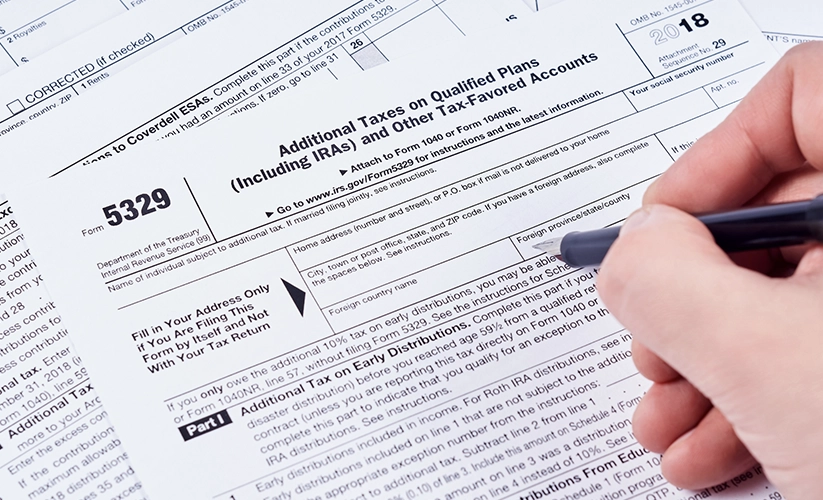Reporting Additional Taxes on Qualified Plans With US Tax Form 5329
Published:
Break the rules on your 401k? This form is how you tell the IRS “I’ll pay the penalty but I’m not trying to break the law.”
Form 5329 is a document provided by the Internal Revenue Service (IRS) that is used to calculate additional taxes on Qualified Plans (including IRAs) and other tax-favored accounts and report them on the taxpayer’s federal income tax return. This form is necessary when additional taxes may apply to tax-advantaged accounts.
These additional taxes can occur in situations such as excess contributions to qualified retirement plans, distributions that are not qualified, early distributions, and other scenarios outlined by the IRS tax laws.
To avoid these distribution penalties in future tax years, it is essential for taxpayers to familiarize themselves with the rules and regulations surrounding tax-advantaged accounts. This includes understanding the annual contribution limits, qualified distributions, and eligible expenses for medical, education, or other purposes.
By following these instructions and staying informed about the rules and regulations surrounding tax-advantaged accounts, taxpayers can effectively manage their qualified plans (including IRAs) and other tax-favored accounts while avoiding unnecessary additional taxes.
You’re Required to File Form 5329 If …
Form 5329 is a crucial document for individuals who receive a distribution subject to taxes attributable to situations outside of the norm, such as
- excess contributions to a qualified retirement plan
- failure to take required minimum distributions
- receiving distributions without meeting the exceptions outlined by the IRS
If you have made excess contributions to a qualifying tax-favored account above your annual limit, such as a health savings account or an education savings account, you must file Form 5329 before the tax filing deadline for the year. Additionally, individuals who have not taken the required minimum distributions from their retirement accounts by the deadline may also need to file this form. (Now, if you’re 50, you can make additional contributions or catch-up contributions beyond those annual limits.)
You might not be required to file this form if you get a 1099-R with a 1 in the distribution code box (and you already owe additional tax based on that form.)
To avoid any penalties or additional taxes in future tax years, it is crucial for taxpayers to become familiar with the rules and regulations surrounding tax-advantaged accounts. Understanding the maximum contribution limits, eligible expenses, and qualified distributions is key to proper tax planning. It is worth noting that you can show that excess contributions might not get a penalty if you can show that it was due to a reasonable error.
The Three Parts of Form 5329
Form 5329 is an important Internal Revenue Service tax form that helps individuals report and calculate any additional tax owed on early distributions, excess contributions, and required minimum distributions from tax-favored accounts. This form is used to reconcile any discrepancies between the amount individuals should have withdrawn or contributed and the actual amounts.
The form is divided into different parts, each addressing specific circumstances. Part I focuses on early distributions from retirement accounts, such as traditional IRAs and employer-sponsored plans. It helps calculate the additional tax owed when individuals withdraw taxable distributions before reaching the age of 59 and a half.
Part II addresses excess contributions to tax-favored accounts, including health savings accounts (HSAs) and education savings accounts (ESAs). By completing this part, individuals can determine if they have made excess contributions and calculate the additional tax due.
Part III deals with required minimum distributions (RMDs) from retirement accounts. Individuals who reach the age of 72 (or 70 ½ if born before July 1, 1949) must take RMDs from their tax-favored accounts. This part helps calculate any additional tax owed if the RMD was not taken in time or the correct amount was not withdrawn.
When Does a Withdrawal from a Retirement Account Count as Early?
If you withdraw any amounts from your qualified tax-favored account before you reach the age of 59½, you could be making an early withdrawal. The Internal Revenue Service (IRS) imposes a penalty on early withdrawals to discourage individuals from tapping into their retirement savings prematurely.
However, there are certain exceptions to this rule. The IRS allows early withdrawals without penalty if the money is used for specific purposes, such as educational expenses, a qualified first-time homebuyer distribution, college expenses or medical expenses.
If you withdraw money from your retirement account before reaching age 59 1⁄2 and the purpose does not qualify for an exception, you will likely be subject to an additional tax penalty, usually 10% of what you withdrew. This penalty is in addition to any income tax due on the withdrawal.
It is crucial to understand the rules and exceptions surrounding early withdrawals from retirement accounts to avoid unnecessary penalties and preserve your savings for the future. Consider consulting a tax professional or reviewing the Form 5329 instructions provided by the Internal Revenue Service for more information.
You Have to Withdraw Money From a Retirement Account When You’re 73 Years Old
If you have an individual retirement account, whether it’s an employer plan or a private plan, it is important to understand the rules for withdrawing money from it. The rules regarding these withdrawals are determined by the Internal Revenue Service (IRS) and are designed to ensure that individuals use their retirement savings for its intended purpose – to fund their retirement years.
Starting from the year in which you turn 73, the IRS requires individuals to begin making annual withdrawals from their retirement accounts. This age requirement for annual withdrawals, also known as required minimum distributions (RMDs), was changed to 73 as of 2023. These withdrawals are mandatory and failure to take them can result in significant penalties. That’s when charitable distributions and other minimum distribution rules come into play.
The amount you are required to withdraw each year is calculated based on your retirement account balance and your life expectancy. The IRS provides tables to help determine the specific amount you need to withdraw. The idea is to ensure that your retirement savings are gradually depleted over time as you enter your retirement years.
How to File Form 5329
To file Form 5329, follow these step-by-step instructions:
- Fill in your information: name, Social Security number, and the tax year for which you are filing the form.
- Determine the purpose of filing: Form 5329 is used to report a qualified retirement plan distribution, such as from a retirement account and health savings account (HSA) subject to additional taxes or penalties. Determine the specific section(s) of the form that apply to your situation based on the instructions provided.
- Calculate the penalties or taxes owed: Each applicable section of the form has specific calculation instructions. Follow these instructions to determine the amount of tax or penalty owed. For example, if you made excess contributions to a retirement account, you may need to calculate the excess contribution amount and additional taxes owed accordingly.
- Fill in the corresponding lines on the form: Transfer the calculated amounts to the appropriate lines on Form 5329. Ensure accuracy and double-check your calculations to avoid any errors.
- Attach supporting documentation: If required, attach any necessary documents to support the amounts reported on the form. This may include Forms 1099-R or other supporting statements.
- Sign and date the form: Before submitting, make sure to sign and date the form to validate your filing.
- Choose your filing method: You can file Form 5329 manually by mailing it to the IRS or electronically using tax preparation software or with the assistance of a tax professional.
- File by the deadline: The deadline for filing Form 5329 typically aligns with the tax return filing deadline, which is April 15th, unless that day falls on a weekend or holiday. Ensure you file the correct form for the applicable tax year.
You Do Not Need to File Form 5329 in These Situations
You may not be required to file Form 5329 depending on the distribution codes shown on other tax forms. The Internal Revenue Service (IRS) has provided guidelines and exceptions to filing requirements, ensuring that individuals do not have to go through unnecessary paperwork.
Here are some situations in which you do not need to file Form 5329:
- You do not have to file Form 5329 if you meet all the requirements for a qualified retirement plan distribution. These requirements pertain to designated beneficiaries, medical expenses, long-term care insurance contracts, health insurance premiums for certain individuals, and public safety employees.
- If your distributions from certain plans or accounts are less than your qualified retirement plan distributions, you are not required to file Form 5329. You have a number of exceptions available to you, such as getting periodic payments for the rest of your life or you and your beneficiary’s joint life expectancies.
- Similarly, if your distributions from an Archer MSA (Archer Medical Savings Accounts), a health savings account (HSA), or an endowment contract are less than your qualified distributions, you do not need to file Form 5329.
- Qualified education expenses are also exempt from Form 5329 filing requirements. If your distributions from an education savings account or a qualified tuition program are less than your education expenses, you are not required to file.



